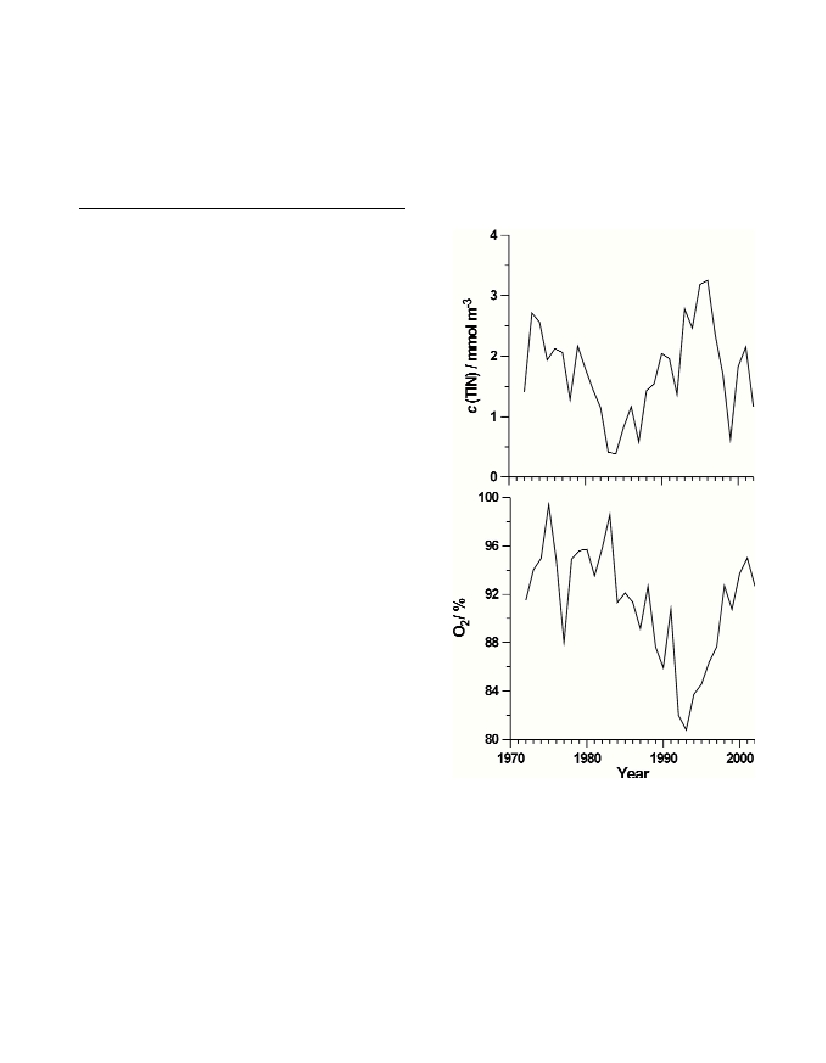Rapp. Comm. int. Mer Médit., 37,2004
216
CHANGES OF OXYGEN SATURATION IN THE BOTTOM LAYER
OF THE MIDDLE-EASTERN ADRIATIC DURING THE PERIOD 1972-2002
G. Kušpilic*, B. Grbec, G. Beg-Paklar, M. Morovic and A. Baric
Institute of Oceanography and Fisheries, 21000 Split, P.O. Box 500, Croatia - * kuspe@izor.hr
Abstract
Based on the results of regular monthly cruises in the area of the middle-eastern Adriatic a drop in oxygen saturation of the bottom layer
was observed in the period 1992-1996. The decrease of oxygen content was coupled with a nutrient enrichment in this layer. This
phenomenon seems to be connected with an unusual low water exchange rate between the Adriatic and the Mediterranean.
Keywords: Adriatic Sea, nutrients, oxygen saturation, time series
Introduction
The upper part of the water column (0-75meters) in the middle-
eastern Adriatic area is throughout the year characterised by moderate
primary production, balanced oxygen saturation and low nutrient
concentrations with relatively small seasonal oscillations. In contrast
to the upper layer, the seasonal variability of nutrient and oxygen
concentrations in the water column below 75 m is much higher and
depends on the vertical particulate organic carbon fluxes and
Levantine intermediate water (LIW) inflow. Extremes of oxygen and
nutrient concentrations in this layer are usually established during late
summer. As the LIWinflow seems to be controlled by a horizontal
pressure difference between the mid-northern Atlantic and the south
eastern Mediterranean (1), large scale interannual climatic variability
could be an important factor for the hydrographic and chemical
properties of deep water layers.
Material and methods
Hydrographic and chemical data collected in the period 1972-2002
from a station in the middle Adriatic Sea (43°00.0’N, 16° 20.0’E)
were analysed. Temperature and salinity were obtained by reversing
thermometers, salinometers and CTD probes, whereas nutrients were
measured on different Technicon AutoAnalysers (I, II and III) and
oxygen by the classical Winkler titration.
Results and discussion
Data analysis of the basic hydrographic and chemical parameters
has shown a pronounced decrease of oxygen saturation as well as an
increase of nutrient concentrations in the bottom layer during the
period 1992-1996(Fig. 1). In contrast to the bottom layer no
significant changes of chemical parameters and primary production in
the euphotic zone were observed. The absence of the relation between
primary production and bottom oxygen content points to circulation
induced changes of chemical properties. In the period 1987-1995the
thermohaline structure in the Adriatic has shown a decreasing
temperature and salinity trend in the intermediate and bottom layer.
These trends agree with observed changes of general thermohaline
Mediterranean circulation (2) indicating lower rates of LIW(saltier
and warmer) inflow to the Adriatic and Adriatic bottom water outflow.
Observed changes of chemical parameters seem to be the result of the
remineralisation of autochthonous organic matter (probably from the
productive area of the northern Adriatic) and a certain stagnation of
the bottom water in the area of south and middle Adriatic.
Conclusion
Observed changes of oxygen saturation and nutrient concentrations
in the bottom layer of the middle Adriatic was found to be in relation
with changes of thermohaline and dynamic properties in this layer.
References
1-Grbec B., Morovic M., and Zore-Armanda M., 2003. Mediterranean
Oscillation and its relationship to salinity ?uctuation in the Adriatic Sea.
Acta Adriat., 44 (1): 61-76.
2-Stratford K., and Haines K., 2002. Modelling changes in Mediteranean
thermohaline circulation 1987-1995. J. Mar. Syst.,33-34: 51-62.
Fig.1. Yearly means of oxygen saturation and dissolved inorganic nitro-
gen concentrations in the bottom layer during 1972-2002.

